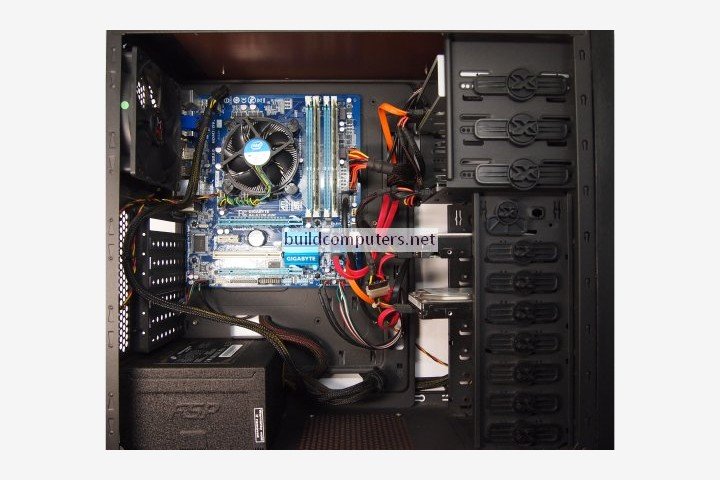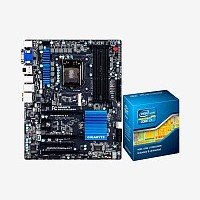Idle, Load and Max CPU Temperatures
What is a normal and safe CPU temperature range? Join us as we reveal Intel and AMD CPU temps during idle, normal and maximum load.
All temperatures listed on this page are for CPUs running at default (non-overclocked) speeds with stock coolers. To give you a better understanding of Intel and AMD CPU operating temps, we have included their temperatures at different usage levels:
- Idle Temperature - Computer idling at Windows desktop (no open windows or programs)
- Load Temperature - Computer under heavy use (heavy gaming, video editing, stress tests)
- Max Temperature - Highest safe CPU temperature (as stated by Intel or AMD)
Running your CPU near its max temperature for long periods will affect its performance and may shorten its lifespan. Once most CPUs hit 90 to 100°C, they will begin throttling (lowering their clock speeds) to avoid overheating. If temperatures rise further, the CPU will shut itself down to avoid permanent damage.
We recommend that you measure the temperatures for your own CPU and compare them with the values below - Click here to learn how to check CPU temps.
Recommended CPU Coolers
Budget Cooler: Cooler Master Hyper 212 Evo
High End Cooler: Noctua NH-D15 Chromax Black
Low Profile Cooler: Noctua NH-L9i (Intel) / Noctua NH-9La-AM4 (AMD)

Intel CPU Temps - Coffee Lake Refresh
|
Idle Temp |
Load Temp |
Max Temp | |
|
Core i3-9100 |
30 to 40°C |
60 to 72°C |
100°C |
|
Core i5-9600K* |
28 to 35°C |
55 to 75°C |
100°C |
|
Core i7-9700K* |
30 to 40°C |
60 to 80°C |
100°C |
*Core i5-9600K and Core i7-9700K aren't bundled with Intel stock coolers. To obtain their idle and normal temperature range, we combined temperature readings from a budget cooler (Cooler Master Hyper 212 Evo) and high end cooler (Noctua NH-D15).
Intel CPU Temps - Coffee Lake
|
Idle Temp |
Load Temp |
Max Temp | |
|
Core i3-8100 |
29 to 40°C |
56 to 69°C |
100°C |
|
Core i5-8400 |
25 to 37°C |
55 to 67°C |
100°C |
|
Core i7-8700K* |
26 to 38°C |
52 to 75°C |
100°C |
*Core i7-8700K isn't bundled with an Intel stock cooler. To obtain its idle and normal temperature range, we combined temperature readings from a budget cooler (Cooler Master Hyper 212 Evo) and high end cooler (Noctua NH-D15).
Intel CPU Temps - Kaby Lake
|
Idle Temp |
Load Temp |
Max Temp | |
|
Core i3-7350K* |
25 to 33°C |
45 to 60°C |
100°C |
|
Core i5-7600K* |
25 to 35°C |
45 to 65°C |
100°C |
|
Core i7-7700K* |
25 to 35°C |
50 to 70°C |
100°C |
*Core i3-7350K, Core i5-7600K and Core i7-7700K aren't bundled with Intel stock coolers. To obtain their idle and normal temperature range, we combined temperature readings from a budget air cooler (Cooler Master Hyper 212 Evo) and high end liquid cooler (Corsair H100i v2).
Intel CPU Temps - Skylake
|
Idle Temp |
Load Temp |
Max Temp | |
|
Core i3-6100 |
30 to 35°C |
48 to 68°C |
70°C |
|
Core i5-6600K* |
24 to 28°C |
42 to 52°C |
72°C |
|
Core i7-6700K* |
26 to 35°C |
53 to 70°C |
72°C |
*Core i5-6600K and Core i7-6700K aren't bundled with Intel stock coolers. To obtain their idle and normal temperature range, we combined temperature readings from a budget air cooler (Cooler Master Hyper 212 Evo) and high end liquid cooler (Corsair H100i GTX).
Intel CPU Temps - Haswell Refresh
|
Idle Temp |
Load Temp |
Max Temp | |
|
Core i3-4160 |
31 to 39°C |
57 to 70°C |
72°C |
|
Core i5-4690K |
32 to 40°C |
60 to 72°C |
73°C |
|
Core i7-4790K |
32 to 39°C |
60 to 80°C |
74°C |
Intel CPU Temps - Haswell
|
Idle Temp |
Load Temp |
Max Temp | |
|
Core i3-4130 |
34 to 38°C |
50 to 61°C |
72°C |
|
Core i5-4670K |
28 to 35°C |
47 to 60°C |
72°C |
|
Core i7-4770K |
34 to 39°C |
55 to 65°C |
67°C |
Intel CPU Temps - Ivy Bridge
|
Idle Temp |
Load Temp |
Max Temp | |
|
Core i3-3220 |
28 to 35°C |
50 to 60°C |
65°C |
|
Core i5-3570K |
28 to 35°C |
50 to 62°C |
67°C |
|
Core i7-3770K |
30 to 40°C |
55 to 65°C |
67°C |
Intel CPU Temps - Sandy Bridge
|
Idle Temp |
Load Temp |
Max Temp | |
|
Core i3-2100 |
30 to 37°C |
50 to 62°C |
69°C |
|
Core i5-2500K |
35 to 41°C |
55 to 65°C |
72°C |
|
Core i7-2600K |
32 to 40°C |
47 to 60°C |
72°C |
Other Factors That Affect Your CPU Temperature Range
Even with default clock speeds and stock coolers, there are still other factors that will affect your normal CPU temperature:
Room Temperature
Ambient room temperatures can affect CPU temps by 5 to 10°C. As a rough gauge, 1°C rise in room temperature = 1 to 1.5°C rise in CPU temps. That's why experienced hardware reviewers and overclockers will factor in their ambient room temperature when taking temperature readings.
Computer Case Cooling
A CPU can run 8 to 10°C cooler in a
spacious computer case with excellent ventilation vs a small, cramped
case filled with dust bunnies. Here's how to check if your computer case
is doing a proper job of keeping the CPU cool:
Measure the temperature of your CPU with its side panels removed (see
image below):

Close the computer case (put back the side panels) and
check its temperature again. If the average CPU temperatures rises
more than 5°C when the case is closed, then your computer case lacks
adequate cooling. You'll need to organize your computer cables, get more (or better) case fans and consider using a modular power supply to minimize clutter.
We
know what you're probably thinking at this point... "Why don't I just
leave the side panels open or go all out
for an open air rig?"
While this method will indeed lower
temperatures in the short run, dust will quickly clog up your heat sinks
and fans (leading to even high temps than before). Therefore it only
works if you're prepared to clean your heat sinks and fans every two to four
weeks. In fact, a good computer case with directed air flow and pressure
difference will run even cooler when closed.
CPU Build Quality
Due to their complex manufacturing process, even CPUs
of the same model and batch can have notable differences in quality.
While defective CPUs are discarded and inferior ones are rebadged, there is still a quality
difference in those that make it past factory inspections.
Getting a high
quality CPU from a store is a matter of luck (which is why overclockers
get so excited when they chance upon a CPU of exceptional quality). All
things being equal, a high quality CPU will run cooler and overclock
better than a typical sample.
Recommended Motherboard CPU Combos
Budget Computer: AMD Athlon 3000G CPU + Gigabyte B450M DS3H Motherboard
Mid Range Computer: AMD Ryzen 5 3400G CPU + Gigabyte B450M Aorus M Motherboard
Gaming Computer: AMD Ryzen 5 3600 CPU + Asus AM4 TUF Gaming X570-Plus Motherboard
Home Theater PC: AMD Ryzen 3 3200G CPU + Gigabyte B450 I Aorus Pro Wi-Fi Motherboard
Click here for our buyer's guide to the best motherboard CPU combos.
CPU GUIDE
- What is a CPU and What Does It Do?
- Recommended Motherboard CPU Combos
- Intel CPU Socket Types
- AMD CPU Socket Types
- How to Check CPU Temperature
- Intel CPU Temperatures - Idle, Load, Max Temps
- AMD CPU Temperatures - Idle, Load, Max Temps
- What is CPU Thermal Paste?
- How to Apply CPU Thermal Grease
- How to Install a CPU
- How to Install a CPU Heatsink Fan

